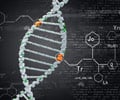In a new research on the genetic defect behind myotonic muscular dystrophy, scientists have found that the mutation disrupts an array of metabolic pathways in muscle cells.
In a new research on the genetic defect behind myotonic muscular dystrophy, scientists have found that the mutation disrupts an array of metabolic pathways in muscle cells through its effects on two key proteins.
The study showed that the loss of a single protein accounts for most of the molecular abnormalities associated with the disease, while loss of a second protein also seems to play an important role.Co-author Manuel Ares, professor of molecular, cell, and developmental biology at the University of California, Santa Cruz, said that each of the affected proteins interacts with an array of genes that are active in muscle cells and other tissues.
The study reveals a cascading sequence of molecular events in which a mutation in one gene ends up affecting hundreds of other genes and the physiological processes that depend on them.
"This is a genetic disease in which there isn't just one gene that is affected. Our hope is that by chasing down more of the affected genes we might be able to figure out how to address more of the symptoms," Nature quoted Ares as saying.
Myotonic dystrophy involves difficulty-relaxing muscles (myotonia) and, as in other muscular dystrophies, progressive muscle weakness and wasting.
The most common type of myotonic dystrophy (type 1) is caused by changes in a gene that has a repeating sequence of three DNA building blocks.
Advertisement
When the defective gene is transcribed into a messenger RNA molecule, the expanded repeat section causes the RNA to bind tightly to certain proteins, forming clumps within the muscle cells.
Advertisement
By binding these proteins in clumps, the abnormal RNA prevents them from carrying out their normal functions in the cell.
Mbnl1 is involved in a process called RNA splicing, in which the messenger RNA copied from a gene gets "edited" before it can direct the synthesis of proteins.
"When a gene is turned on, its DNA sequence gets copied into a messenger RNA molecule. But that direct copy needs to be processed to make a functional message that can be translated into a protein. Splicing factors like Mbnl1 tell the splicing machinery where to do the cutting and pasting. Without Mbnl1, incorrect splicing can affect lots of different genes," said Ares.
Ares has pioneered the use of microarray technology to detect changes in RNA splicing caused by genetic mutations and other perturbations.
Charles Thornton's lab at the University of Rochester School of Medicine developed a mouse strain that expresses large amounts of the abnormal repeat RNA in muscle cells.
Maurice Swanson's lab at the University of Florida College of Medicine developed a mouse strain that is unable to make the Mbnl1 protein. Both strains of mice show symptoms similar to myotonic dystrophy.
Ares's lab used splicing-sensitive microarrays developed in collaboration with Affymetrix to show that the RNA splicing defects in muscle cells from these two mouse strains are nearly the same.
This indicates that the vast majority of the splicing problems are due to the loss of the Mbnl1 protein as a result of binding to the abnormal repeat RNA.
Earlier studies had associated several splicing defects with the disease, but the microarrays revealed effects on a much larger number of genes.
"Our microarray methods detected hundreds of splicing events that were being affected, giving us a broader picture of what's going on in cells as the disease is taking hold," said Ares.
The study has been published in Nature Structural and Molecular Biology. (ANI)
Source-ANI
SAV














